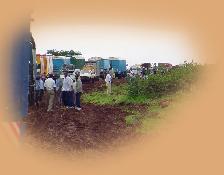Travelling Advice
About Us
Safariing
Travelling
Accommodation
Equipment & Gadgets
Souvenirs
Clothing
Safari Activities
Coastal Activities
Security
Health
Where
When
Experiences
Slideshows
Evolution
Contacts
Site Map
Sub Site
Roads 'Roads' in East Africa describes a wide range of wheeled-vehicle thoroughfares from the very basic track to black-topped dual carriageways - there are no motorways (or freeways) as we know them. Roads between major towns are generally black-top single carriageways, which you'll only use on the long-haul routes between game parks. All routes within the parks are tracks with the more popular routes graded at irregular intervals, with drainage channels and concreted watercourse crossings (dry for much of the year). This ensures tourists at least get to their accommodation in the rainy seasons. |
||
 Above the Rift Valley 23rd Dec. 2000 |
In dry seasons the plains are pretty much dust bowls with dust billowing around you as the vehicles disturb the surface. It's then a choice of whether you open all the windows to clear it quicker or shut them to stop it getting in in the first place. 'Dust-devils' are common. |
 Amboseli. 24th Jul. 2005 |
Vehicles The most common safari vehicle by far is the two-wheel-drive mini-bus, used by most package tour operators and some of the smaller local agents. They have opening roofs to allow tourists to get a better view and photographs whilst providing a sun-cover. The vehicles have to be in reasonable condition, although wouldn't pass many Western PSV regulations. In recent months the Kenyan authorities have regulated that every tourist must have their own window seat, although this is not strictly adhered to. |
 |
|
Local Travel There are no scheduled bus services in East Africa, except for the long distance coaches between major towns. Taxis are by far the best choice for travelling independently about town. Most are privately owned and barely in roadworthy condition. One of our operators stopped using one driver when he had to borrow a friends car to get us to the airport on time! |
||
Lunatic Express - the overnight train from Mombasa to Nairobi |
||
 Towards Nairobi. 28th Dec. 1996 |
We are unaware of any operator using trains anywhere in East Africa, so unless you are one of the more intrepid travellers making your own arrangements you're unlikely to come across this service. This may also be because the tracks are often washed away in the rainy season turning a 12 hour journey into 6-7 days! But just in case... |
|
The execution however, was very slightly awry: the sleeping berth had no locks on the door; the furnishings were overdue for replacement (but that can also be said of many smaller family hotels in the U.K.); the waiter's gloves and jacket were two sizes too big for him; and, our waiter was three-sheets-to-the-wind before we got on! That didn't stop him spotting an opportunity. He mugged us for a bottle of red wine at KSh1,800 which hadn't travelled too well! |
||
Internal Flights |
||
As we've already experienced the roads and train we now tend to fly as much as possible, giving us more time on safari - which is what it's all about! |
 Outside the Mara. 13th Sept. 1999 |
|
Regional Air (a BA partner) provided scheduled flights to and within Tanzania. |
||
Charter Flights |
||
You may also need to charter your own flights for the private game reserves or to suit your program without overnight stops in town. As you may expect these can be rather small aircraft, often single engined which can be less stable, especially flying over the highlands. I have often flown in the co-pilot's seat. One advantage of charter flights is you can often get a flying safari in on the way if conditions are right and the pilot has time. |
||
International Flights International flights land at a few airports: Nairobi - for scheduled services to Kenya; Mombasa - for charter flights used by most package operators to Kenya; Kilimanjaro or Dar-es-Salaam to Tanzania. Although operators advise visas are required before travelling, these can be purchased at the airport with hard currency (US$, £ Sterling are accepted in both countries) with no more delay than for baggage, which is far easier than applying to your local embassy. Travellers to Kenya now need to pre-purchase an electronic travel authorisation. |
||